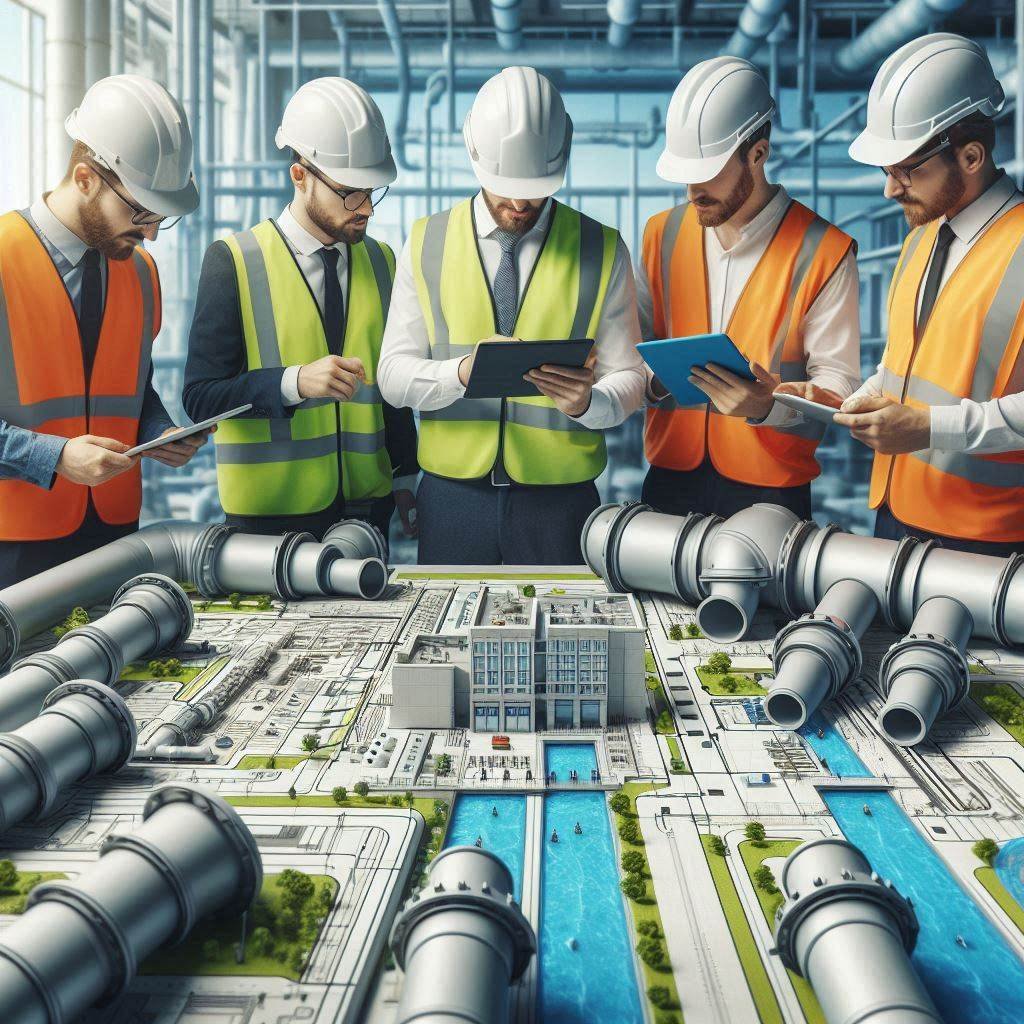In today’s world, where efficiency and sustainability are imperatives, BIM methodology emerges as an essential tool for transforming basic sanitation projects. With its ability to integrate precise and detailed information from the planning phase through to execution and maintenance, BIM not only enhances the quality and accuracy of projects but also optimizes resources and reduces costs. In this post, we will explore the crucial role of BIM in basic sanitation projects, highlighting how this methodology is revolutionizing the way we approach and solve challenges related to water infrastructure and waste treatment.
What are the Possible Applications of BIM Methodology in Basic Sanitation Projects?
BIM methodology has various applications in basic sanitation projects, each contributing to the efficiency, accuracy, and sustainability of these projects. Some of the main applications include:
Planning and Integrated Design
3D Modeling: Creation of detailed three-dimensional models of water and sewage networks, allowing more precise visualization and analysis of infrastructures.
Interdisciplinary Coordination: Integration of different disciplines (civil, hydraulic, environmental engineering) into a single model, facilitating communication and coordination between project teams.
Analysis and Simulation
Hydraulic Analysis: Simulation of the behavior of water and sewage networks to identify possible capacity and performance issues.
Scenario Simulation: Evaluation of different design scenarios to optimize resource use and ensure infrastructure resilience.
Construction Management
Construction Planning: Use of BIM models for sequencing construction activities, improving planning and execution of works.
Cost Control: Real-time cost monitoring, allowing quick and precise adjustments to the project budget.
Operation and Maintenance
Asset Management: Creation of a digital database that facilitates asset management throughout the entire lifecycle of the infrastructure.
Preventive Maintenance: Use of BIM model data to plan and execute preventive maintenance, increasing the lifespan of infrastructures and reducing repair costs.
Sustainability and Energy Efficiency
Environmental Assessment: Analysis of the environmental impact of sanitation projects, promoting more sustainable solutions.
Energy Efficiency: Optimization of energy use in treatment plants and water distribution networks, contributing to reduced energy consumption and carbon emissions.
Risk Management and Safety
Risk Identification: Identification and mitigation of potential risks during the design and construction phase using detailed simulations and analyses.
Workplace Safety: Safety planning on the construction site, minimizing accidents and ensuring compliance with safety standards.
What are the Specific Benefits for Basic Sanitation Projects with the Use of BIM?
The use of BIM methodology in basic sanitation projects brings several significant benefits. Here are some of the most impactful ones when it comes to the specificity of basic sanitation:
Optimization of Infrastructure Lifecycle
BIM is not limited to the construction phase; it follows the project throughout its entire lifecycle, from planning to operation and maintenance. This enables more efficient asset management, with access to detailed data about the infrastructure, facilitating preventive maintenance and prolonging the lifespan of sanitation systems.
Greater Sustainability and Energy Efficiency
BIM methodology allows for detailed analysis of the environmental impact and energy performance of basic sanitation projects. This enables the implementation of more sustainable solutions and optimization of resource use, contributing to the reduction of ecological footprint and energy consumption.
Water Resources Monitoring and Management
With the use of BIM, it is possible to integrate geospatial and hydraulic data to simulate the behavior of water distribution and sewage collection networks. This allows for more precise monitoring of water flow, leak detection, and system efficiency analysis. Simulations help identify areas with high demand or vulnerable to flooding, enabling more effective water resource management.
Efficient Management of Underground Networks
BIM facilitates precise modeling of underground water and sewage networks, providing a detailed view of the location and interconnection of pipes, valves, and other components. This is crucial to avoid conflicts with other underground infrastructures, such as electrical and telecommunications cables, minimizing the risk of damage during excavation and construction. Detailed visualization also aids in planning future expansions or repairs.
What Priorities Should I Consider When Implementing BIM in My Basic Sanitation Projects Company?
Team Training and Development
Investment in Training: Ensure that all team members, from engineers to project managers, receive adequate training to use BIM tools and software. This includes not only the technical understanding of the tools but also the integration of BIM principles into daily work practices.
Continuous Development: Implement ongoing education programs to keep the team updated on the latest innovations and best practices in BIM, ensuring they can fully leverage the methodology’s potential.
Integration of Processes and Tools
Adaptation of Work Processes: Review and adjust the company’s internal processes to effectively integrate BIM. This may include redefining workflows, establishing new procedures for coordination and collaboration among different disciplines.
Selection of Appropriate Tools: Choose the most suitable BIM software tools for the specific needs of basic sanitation projects, ensuring compatibility and ease of use. Integration with other project management and data analysis tools is also essential.
Data Management and Information Quality
Implementation of Data Standards: Establish clear standards for creating, managing, and sharing data within BIM models. This includes defining file formats, nomenclature, and documentation practices to ensure consistency and accuracy.
Rigorous Quality Control: Implement strict quality control procedures to review and validate the information contained in BIM models. This ensures that the data is accurate and reliable, reducing the possibility of errors and rework during construction and maintenance phases.
BIM as a Pillar of Innovation in Basic Sanitation Projects
The implementation of BIM in basic sanitation projects is revolutionizing how we plan, design, and manage the essential infrastructure for public health and the environment. With benefits ranging from improved project accuracy to efficient water resource management and regulatory compliance, BIM stands out as an indispensable tool for addressing the complex challenges of this sector.
By adopting this methodology, basic sanitation companies can not only optimize processes and reduce costs but also significantly contribute to the sustainability and resilience of the communities they serve. Thus, BIM is not just a technological innovation but a strategic advance shaping the future of sanitation with efficiency and responsibility.




Deixe um comentário